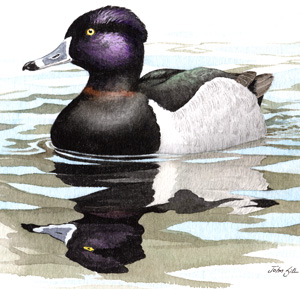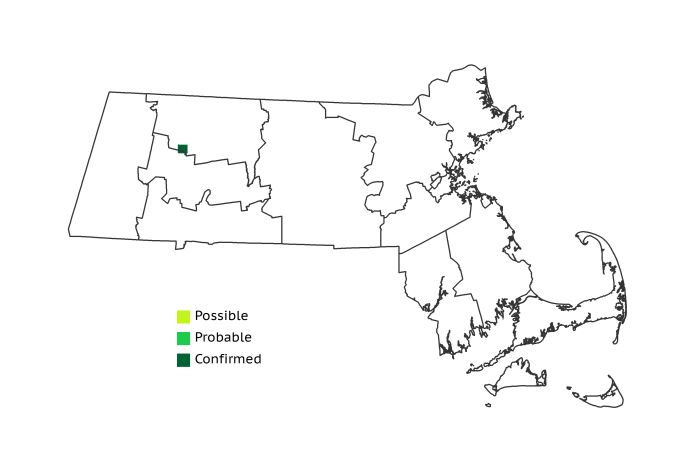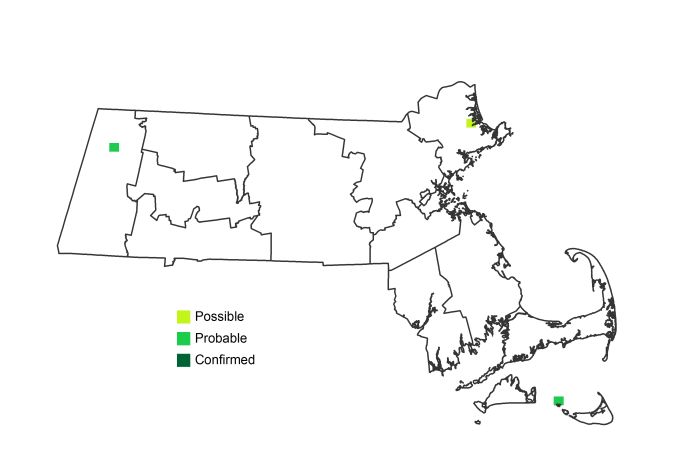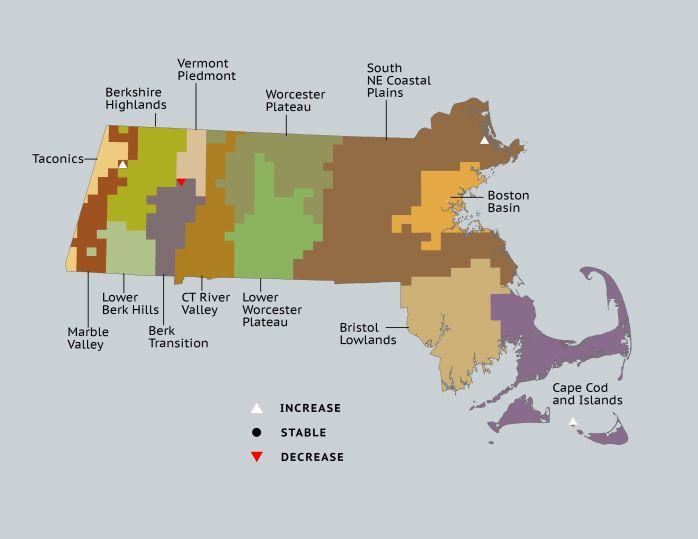Breeding Bird Atlases (BBA)
Find a Bird
Ring-necked Duck
Aythya collaris

Very local, trend not established
“Birds are named for their least visible field marks.” – Birder’s maxim
Ring-necked Ducks were originally named, rather inappropriately, for the inconspicuous brown ring on their necks that males possess when they are in breeding plumage. Many sportsmen and naturalists know this species instead as “Ringbill,” a much more fitting appellation describing one of the species’ most visible field marks. In the modern era, these diving ducks are typically seen in Massachusetts during migration and winter but have historically been practically absent as breeding birds.
Historic Status
At the time that Samuel Cabot Jr. shot a Ring-necked Duck in Cambridge’s Fresh Pond in the 1830s, little was known about the species by Massachusetts ornithologists. It was believed to breed “in the fur countries” to the north and west, but the first nests had yet to be discovered (Peabody 1839). And so the story would go for nearly a century. Occasional stragglers would find their way to Massachusetts each spring and fall, and even in the 1920s Edward Howe Forbush still called it “one of the rarest ducks of the Northeast” (Forbush 1925). At that time, though, a range expansion was underway as the species began an eastward colonization across Canada that brought an increasing number of migrants through the eastern United States by the 1930s. In 1947 and 1951, Ring-necked Ducks actually nested in Concord, however, these were singular occurrences (Petersen & Meservey 2003).
Atlas 1 Distribution
Ring-necked Ducks maintained a tradition of breeding scarcity through the years of Atlas 1. Though by the 1970s Ring-necked Ducks were a common and familiar duck during migration, especially in the fall, only one instance of breeding evidence was found through the entirety of the Atlas 1 project. This singular occurrence involved a Confirmation in Ashfield, in the Berkshire Highlands region.
Atlas 2 Distribution and Change
The Ring-necked Duck was not Confirmed at all during Atlas 2 and was detected in only 3 blocks during Safe Dates. Future breeding records for this species seem likely, but it will probably remain a rarity as a breeder in the Commonwealth.
Atlas 1 Map

Atlas 2 Map

Atlas Change Map

Ecoregion Data
Atlas 1 | Atlas 2 | Change | ||||||
Ecoregion | # Blocks | % Blocks | % of Range | # Blocks | % Blocks | % of Range | Change in # Blocks | Change in % Blocks |
Taconic Mountains | 0 | 0.0 | 0.0 | 0 | 0.0 | 0.0 | 0 | 0.0 |
Marble Valleys/Housatonic Valley | 0 | 0.0 | 0.0 | 1 | 2.6 | 33.3 | 1 | 2.6 |
Berkshire Highlands | 0 | 0.0 | 0.0 | 0 | 0.0 | 0.0 | 0 | 0.0 |
Lower Berkshire Hills | 0 | 0.0 | 0.0 | 0 | 0.0 | 0.0 | 0 | 0.0 |
Vermont Piedmont | 0 | 0.0 | 0.0 | 0 | 0.0 | 0.0 | 0 | 0.0 |
Berkshire Transition | 1 | 2.6 | 100.0 | 0 | 0.0 | 0.0 | -1 | -3.2 |
Connecticut River Valley | 0 | 0.0 | 0.0 | 0 | 0.0 | 0.0 | 0 | 0.0 |
Worcester Plateau | 0 | 0.0 | 0.0 | 0 | 0.0 | 0.0 | 0 | 0.0 |
Lower Worcester Plateau | 0 | 0.0 | 0.0 | 0 | 0.0 | 0.0 | 0 | 0.0 |
S. New England Coastal Plains and Hills | 0 | 0.0 | 0.0 | 1 | 0.4 | 33.3 | 1 | 0.4 |
Boston Basin | 0 | 0.0 | 0.0 | 0 | 0.0 | 0.0 | 0 | 0.0 |
Bristol and Narragansett Lowlands | 0 | 0.0 | 0.0 | 0 | 0.0 | 0.0 | 0 | 0.0 |
Cape Cod and Islands | 0 | 0.0 | 0.0 | 1 | 0.7 | 33.3 | 1 | 0.8 |
Statewide Total | 1 | 0.1 | 100.0 | 3 | 0.3 | 100.0 | 2 | 0.2 |



